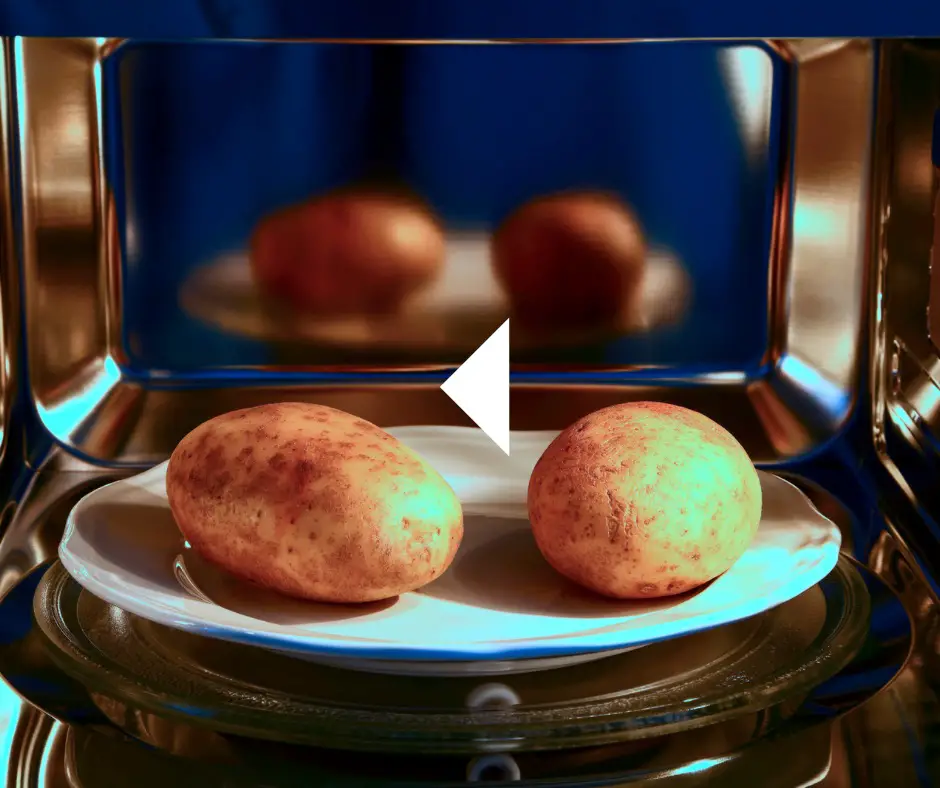Baking potatoes in the oven can take up to an hour, but what if you don’t have that much time?
You can use your microwave to cook potatoes in a fraction of the time, and still get a fluffy and tender result.
In this article, we will show you how to bake potatoes in the microwave, how long it takes and some tips and tricks to make them even more delicious.

How Long Does It Take To Cook Potatoes In The Microwave?
The cooking time of potatoes in the microwave varies depending on three factors: how big the potatoes are, how many you want to cook, and how powerful your microwave is.
To find out the wattage of your microwave, look at the Owner’s Manual or the label on the back of the appliance. Then, follow the table below to adjust the cooking time accordingly.
Quick Note: Small Potatoes: less than 5 ounces, Medium Potatoes: 5-8 ounces, Large Potatoes: 9-12 ounces.
| Wattage (WATT) | Potato Size: Serving = Time in minutes |
|---|---|
| 600 WATT | Small potato: one = 3:30, two = 5:50, three = 11:40, four = 16:20. Medium potato: one = 7, two = 11:40, three = 17:30, four = 25:40. Large potato: one = 10:30, two = 17:30, three = 23:20, four = 29:10. |
| 700 WATT | Small potato: one = 3, two = 5, three = 10, four = 14. Medium potato: one = 6, two = 10, three = 15, four = 22. Large potato: one = 9, two = 15, three = 20, four = 25. |
| 800 WATT | Small potato: one = 2:38, two = 4:23, three = 8:45, four = 12:15. Medium potato: one = 5:15, two = 8:45, three = 13:08, four = 19:15. Large potato: one = 7:53, two = 13:08, three = 17:30, four = 22:15. |
| 900 WATT | Small potato: one = 2:20, two = 3:53, three = 7:47, four = 10:53. Medium potato: one = 4:40, two = 7:47, three = 11:40, four = 17:07. Large potato: one = 7, two = 11:40, three = 15:33, four = 19:26. |
| 1000 WATT | Small potato: one = 2:06, two = 3:30, three = 7:00, four = 9:48. Medium potato: one = 4:12, two = 7:00, three = 10:30, four = 15:24. Large potato: one = 6:18, two = 10:30, three = 14, four = 17:20. |
| 1100 WATT | Small potato: one = 1:55, two = 3:11, three = 6:22, four = 8:53. Medium potato: one = 3:49, two = 6:22, three = 9:31, four = 13:57. Large potato: one = 5:44, two = 9:31, three = 12:41, four = 15:51. |
| 1200 WATT | Small potato: one = 1:45, two = 2:55, three = 5:50, four = 8:10. Medium potato: one = 3:30, two = 5:50, three = 8:45, four = 12:50. Large potato: one = 5:15, two = 8:45, three = 11:40, four = 14:35. |
| Chart Notes | The chart does not guarantee accurate timing for baking potatoes in the microwave oven. It should be used only as a reference for determining the correct cooking times. You may need to adjust the cooking times further or below to eventually perfect the potatoes. |
| Instructions | 1) Microwave on HIGH (which is the maximum power setting on your microwave oven i.e 10%). 2) Flip potatoes halfway through cooking time to ensure even cooking. 3) At the end of cooking time, check if potatoes are fork tender or their internal temperature registers 210°F. If not, return back to the microwave, cook at 1 minute bursts and continue to check for doneness after each interval. 4) Let potatoes stand for additional 2 minutes before serving (outside the microwave). 5) Microwave a maximum of 4 potatoes at a time. |
How To Microwave Potatoes
Follow these steps to microwave potatoes:
Pick the right potatoes
For baking, you want potatoes that are high in starch and low in moisture, such as Russet, Round white, Yellow Finn, or Yukon Gold.
These potatoes will have a fluffy and dry texture when cooked, unlike waxy potatoes that are more moist and creamy.
Avoid potatoes that are wrinkled, sprouted, or greenish, as they may be old or contain a bitter and toxic substance called solanine.
Wash and dry potatoes well
Potatoes are grown underground, so they may have dirt and sand on their skins.
To clean them, you can either soak them in a bowl of lukewarm water with some white vinegar for a few minutes, or scrub them under running water with a brush.
Rinse them thoroughly and pat them dry with a paper towel.
If you are concerned about the chemicals that may be sprayed on conventionally grown potatoes, you can choose organic potatoes instead.
Poke holes on potatoes
This step is important to prevent the potatoes from exploding in the microwave due to the build-up of steam inside.
Use a fork to poke three holes on each side of the potato. This will also allow some of the seasonings to penetrate the potato and enhance the flavor.
Season potatoes
You can season your potatoes with salt and pepper, or any other spices you like. We recommend adding some garlic powder for extra taste. Sprinkle the seasonings evenly over the potatoes.
Microwave the potatoes
Refer to the chart at the top of this page for the approximate cooking time based on the size and number of potatoes.
Place the potatoes on a microwave-safe plate or dish and microwave on high power.
Flip the potatoes halfway through the cooking time for even heating.
Check if the potatoes are done by inserting a knife or fork into them. If they are still hard, microwave for another minute and check again.
Enjoy your potatoes
Once your potatoes are cooked, let them rest for a few minutes before cutting them open.
You can add any toppings you like, such as butter, sour cream, cheese, bacon, chives, chili, or beef.
How To Cook Potatoes In The Microwave Cubed
A well-prepared cube of potato starts by giving it a good wash and chopping the tuber into inch-sized pieces.
The skin can either stay or go as per your personal preference.
Once ready, lay out the potato cubes in a microwave-friendly dish.
Add a generous sprinkling of olive oil and season them to taste; salt and pepper are basics with room for expansion—garlic powder, oregano or any preferred spices can be added to achieve an extra flavor kick.
Cook them at full power for about 15 minutes, occasionally stirring them around to ensure even cookery until they’re tender and crisped up to perfection.
However, depending on the number and size of your potatoes as well as microwave strength, cooking time might need tweaking. Refer above to the table.
Serve these cooked wonders as side dishes or elevate them into main meals by adding cheese, bacon, sour cream – pretty much anything goes!
Now let’s talk tips:
To ensure each potato cube gets an equal share of heatwave love, use a large enough dish that allows all pieces to comfortably spread in one layer.
Covering this dish with either a lid or paper towel traps moisture preventing the dreaded dry-out effect.
Be vigilant and check on your spuds regularly! Stirring them around during cooking prevents potential burning or overcooking incidents.
A simple fork or knife test will tell you if they’re perfectly prepped; if they pierce through without resistance – they’re done!
Do You Put Plastic Wrap On Potatoes When Microwaving?
Plastic wrap can act as a remarkable ally in your potato cooking adventure due to its steam-trapping capabilities.
This aids in speedier, more consistent cooking and safeguards your potatoes against drying out during the process.
Yet, using plastic wrap isn’t without its drawbacks.
If the wrap isn’t designated as microwave-safe or overheats during cooking, it has the potential to melt and release unwanted chemicals into your prize spuds.
And for those who relish a crisp skin on their potatoes, be warned: plastic wrap may result in a soggy exterior.
Intending to use plastic wrap to microwave your potato?
Here is how to do so:
Firstly, rinse your potato thoroughly and dry it. Use a fork or knife to pierce some holes into it – this will allow steam to escape and break down its starches during cooking.
Wrap the potato with plastic wrap loosely leaving some room for steam to escape.
Place your wrapped potato on a microwave-safe dish and follow the recommended microwaving time for potatoes (flipping halfway through for even heating).
To check if your potato is ready, gently squeeze it or insert a fork or knife into its center. If it’s still firm, pop it back into the microwave for an additional minute before checking again.
Once cooked through, slice open your steaming hot potato and garnish with toppings of choice.
Note: Always ensure that any plastic wraps used are labeled as microwave-safe to avoid any health risks they could pose when exposed to high temperatures.
Quick Microwave Baked Potato Recipe
Ingredients:
- 4 medium potatoes (8 ounces each)
- 1 tablespoon of butter
- Salt and pepper to taste
Directions:
- Wash and dry the potatoes well. Poke them with a fork several times on each side.
- Place the potatoes on a paper towel-lined microwave-safe plate or dish. Microwave on high power (700 watt) for 22 minutes, flipping them over halfway through. The potatoes are done when they are soft and have an internal temperature of 210°F.
- Cut a slit on the top of each potato and squeeze the ends to open them up. Add butter, salt, and pepper as desired.
- Enjoy your microwave baked potatoes.
Notes:
This recipe is for a 700 watt microwave oven. If you have a different wattage, adjust the cooking time according to the chart at the top of the page.
Is It Safe To Microwave A Potato?
You don’t have to worry about losing the health benefits of potatoes when you microwave them.
According to the nutritional fact sheets from the United States Department of Agriculture (USDA) for 100 g of microwaved potato and 100 g of oven baked potato, microwaving a potato does not affect its nutrients any more than baking it in a conventional oven.
Here are the main points from the nutritional fact sheets (in case you don’t have time to look at them).
| Nutrient | Oven baked potato (100 g) | Microwaved Potato (100 g) |
|---|---|---|
| Dietary Fiber | 2.2 g | 2.3 g |
| Protein | 2.5 g | 2.44 g |
| Vitamin C | 9.6 mg | 15.1 mg |
| Vitamin B6 | 0.311 mg | 0.344 mg |
| Pantothenic Acid | 0.376 mg | 0.454 mg |
| Iron | 1.08 mg | 1.25 mg |
| Magnesium | 28 mg | 27 mg |
| Phosphorus | 70 mg | 105 mg |
| Potassium | 535 mg | 447 mg |
| Copper | 0.118 mg | 0.334 mg |
| Manganese | 0.219 mg | 0.292 mg |
The table above shows that the nutrients in both potatoes are very similar.
There is a slight decrease in the amount of Protein, Potassium and Magnesium that make up the daily value dose— for a 100 g microwaved potato.
However, it has a higher amount of Dietary Fiber, Vitamin C, Vitamin B6, Pantothenic acid and the other minerals.


SOOO helpful, thank you!!